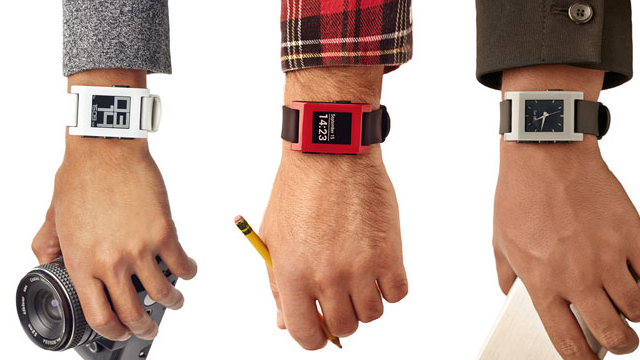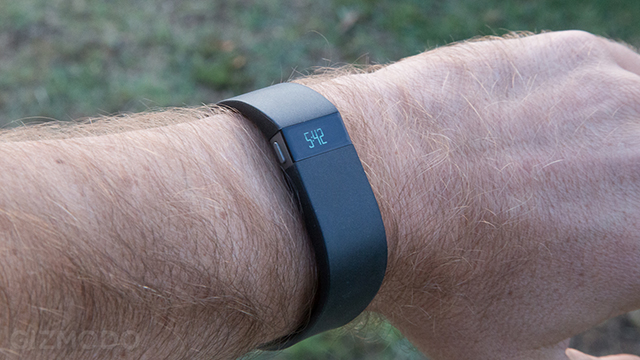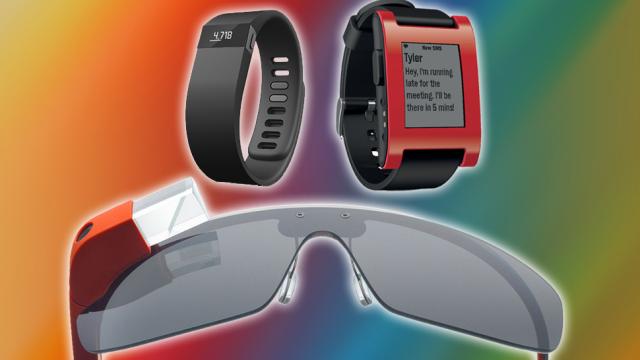With all the hoopla over smartwatches, Google Glass and other forms of wearable computing, you’d think the revolution had already happened. Now the Christmas shopping season is coming near. Should wearables be on your list?
We talked earlier this year about smartwatches, and in the few months since, Samsung has entered the game with its Galaxy-exclusive offering. However, watches aren’t the only thing going on. Between Glass, Fitbit, Nike and the slew of other smart wearables out there, the tech world is poised to strap intelligent sensor-stuffed gadgets all over your body. Should you care, though?
What Do Wearable Computers Really Do?
The inevitable question when it comes to wearable devices is what benefit they really provide over your smartphone. You can already send text messages and check Facebook from your phone. What’s the point of putting it all on a watch or your face?
Wearables typically offer some combination of the following benefits:
- Quicker access to notifications. If you want to read the entire text of your email or mess around on Facebook for a couple of hours, your phone is a great tool. However, the ability to filter out the important messages from the mundane ones can be a huge time saver. Active Notifications on the Moto X (and the independently-developed app of the same name for other devices) can make a phone a little better at quickly telling us what’s important, but if your phone is in your pocket, it doesn’t help much.
- Heads-up information and ubiquitous search. Google Glass has a reputation for wowing its users by allowing them to display relevant information such as directions without having to constantly glance down at their phone, and providing always-on, hands-free Google searches. Think of it like your own personal Jarvis (only without the quirky personality).
- Recorded data and feedback. Perhaps the most useful function for wearable devices is taking telemetric data recordings and providing useful feedback. Devices like Fitbit and the Nike+ Fuelband track your workout and provide detailed information that can not only inform your workout, but motivate you as well.
Is this enough to justify an entirely new device? Hard to say. On the one hand, device like the Fitbit and Nike+ have done fairly well for the markets they target, but smartwatches haven’t really been flying off the shelves (and Samsung’s Galaxy Gear is allegedly seeing a return rate of about 30 per cent). So, does that mean that you should ignore the entire market? Well, maybe not.
Which Ones Are Worth My Time?

Whether or not you should pay attention to the wearables market depends heavily on what your needs are (if you’re into fitness, you’re probably a candidate). This is the state of wearable tech and where it’s going.
Watches
The Present: So far, the most popular smart watch that hasn’t been universally panned is the Pebble (and it was our favourite too). The Galaxy Gear has the highest brand recognition of all the devices currently on the market but our friends at Gizmodo found it to be less than stellar at a much higher price point. We went over some of the other smartwatches already available on the market and which ones may be worth your time in this post.
The Future: While there are a few smartwatches on the market already, rumours have it that there are only about three people on earth that aren’t currently making a smartwatch. HTC, Qualcomm, and most notably Google are all allegedly working on a device. While it’s not always the best idea to base your buying decisions on rumour, smartwatches are a luxury item and the only big name in the game right now is Samsung. You probably won’t miss out on anything big by waiting a little.
Glasses
The Present: If you want to get your hands on a heads-up display like Glass today, your best bet is to know someone who already has one that has an invite to give out, and about $1,500 laying around. That’s going to be a tough call for most of us, so chances are you’re just going to have to sit this one out. However, if you’re one of the lucky (and wealthy) few, you can get version 2 of the hardware which, among other changes, adds support for future shades and prescription lenses. What this means for the rest of us is that when Glass finally arrives, it might be easier to blend it into your normal wardrobe. That is, if you wear glasses or shades.
The Future: As with smartwatches, the storm is still coming for Glass-like devices. Vuzix has already demoed its own wearable device that competes directly with Google Glass at CES this year. Microsoft and Samsung may also be building their own versions. In this case, virtually all of your options are unavailable at this point, but they’re coming. We’d advise a “wait and see” approach but that’s more or less mandatory for those of us that aren’t made of money.
Fitness Trackers
The Present: Fitness trackers are perhaps the most evolved and polished of all wearable computing devices and, consequently, the easiest to recommend. Devices like the Fitbit, Jawbone Up and Nike+ Fuelband are proven and competent accessories for your workout routine. Of course, you’ll have to weigh the cost versus the investment. For many people, a smartphone can do most of the same work.
The Future: Fitness trackers are just going to keep getting better. One contender is IndieGogo graduate Amiigo. In addition to the basics (calorie count, step tracker.), the Amiigo claims to be able to detect, count, and measure any workout you do. You can probably expect that competing devices will follow a similar path as software gets better.
So, Should I Get A Wearable Computer?

When I began writing this piece, I expected to find a few devices that are worth buying right now, even if the future is going to be a lot better. However, outside of the fitness trackers and possibly the Pebble, almost universally the answer is “I’d wait.” And even those are only for certain, niche audiences.
Wearable computing is a trend that’s coming whether we want it or not. Nearly every consumer electronics company around is trying to crack the code and some of them might just do it. However, if they’re going to do so, it probably won’t be this year. The 2013 Christmas shopping season is fast approaching and it can be tempting to lay down cash for a nice new toy. However, while typical gadget wisdom says there’s always something new and shiny coming down the road, there are some good and bad times to buy certain gadgets. Right now is, unfortunately, not a good time to get into the wearables game.

Comments
3 responses to “Wearable Computing: Is It Ready For Prime Time?”
Lack of usable interface hold all these devices back. A smartwatch/glasses that inform you of a message isn’t much more useful than your phone vibrating in your pocket if you can’t respond easily without pulling out your phone. Until something ground breaking comes along like say eye tracking key entry, I don’t see these being of any real use.
Google Glass is begging for widespread and graphical augmented reality to be of any real use. This will take years to build organically. Even then this will be segmented across different provides in the same way map data such as reviews is split across Google Maps, Yelp, TripAdvisor, Foursquare.
Fitness device seem like short-lived single function devices that will disappear in the same way smartphones killed SatNav and Palm PDA devices.
Just posted a comment about them, but have you heard of Meta? They’re going straight for 3D augmented reality. The design needs to grow (and is already looking better for the early 2014 consumer version), but it seems a lot more promising in the way of AR than Google
https://www.spaceglasses.com/
I don’t get the fuss over Glass and why people are acting like its the only thing happening at this very moment in the glasses space. It’s vanilla augmented reality at best, it offers notifications and feeds the narcissistic need to share EVERYTHING.
Meta is another type of glasses project, about to ship to developers, with a slimmed down version for consumers to follow a few months later. THIS is the present and future of glasses and augmented reality:
https://www.spaceglasses.com/
The guys at Meta KNOW what AR is, and now its just about getting the interface and physical design right.